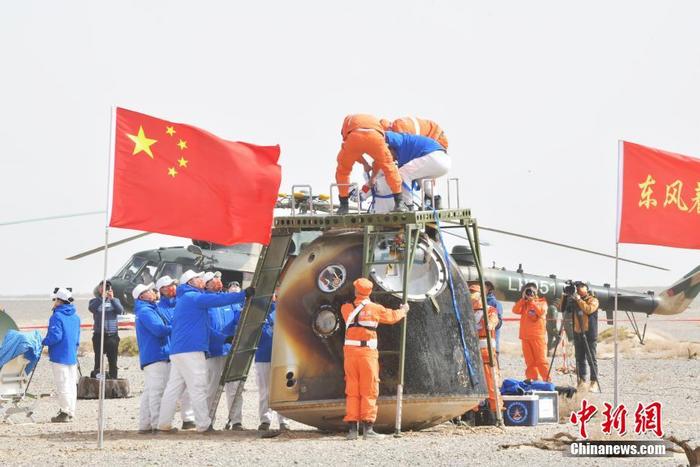China News Agency, Beijing, April 17th. Comprehensive news: At 9:56 on April 16th, Beijing time, the return capsule of China's Shenzhou 13 manned spacecraft successfully landed at the Dongfeng Landing Site.
A number of foreign media have paid attention to the "record" moment of the Shenzhou 13 manned mission and reported on the six-month space life of the three Chinese astronauts.
In addition, China's future space program has also attracted the attention of many foreign media.
"A record-breaking human spaceflight mission"
Many foreign media have paid attention to the "record" moment in China's manned space mission.
According to a Reuters report on the 16th, three Chinese astronauts returned to Earth on Saturday after living in space for 183 days, completing China's longest manned space mission to date.
The US space news website "Space.com" believes that China's record-setting Shenzhou 13 mission has been "recorded in the books."
The media report said the landing ended the Shenzhou 13 mission, which remained in orbit for six months, setting a Chinese record.
China's previous longest manned mission was Shenzhou 12, which lasted 92 days.
On April 16, the Shenzhou 13 manned spacecraft return capsule successfully landed in the predetermined area of the Dongfeng Landing Site.
Photo by Zhang Jie issued by China News Agency
Many media have paid attention to the "space record" set by Chinese women.
The Associated Press reported on the 16th that during this mission, astronaut Wang Yaping completed the first spacewalk of a Chinese woman.
In November last year, Wang Yaping became China's first woman to perform an extravehicular spacewalk, and she and Zhai Zhigang installed space station equipment during a six-hour spacewalk, Agence France-Presse reported.
In addition, some media noticed the return speed of Shenzhou 13.
Singapore's "Lianhe Zaobao" reported on the 16th that Shenzhou 13 is currently China's spacecraft with the longest stay in orbit and the fastest return spacecraft.
The Russian Satellite News Agency reported that in order to further improve the efficiency of the return mission and shorten the implementation time of ground flight control, Shenzhou 13 adopted the fast return mode for the first time.
By appropriately cutting and adjusting the flight tasks, and compressing the operation time, the time required for return is reduced from the original 11 flight laps to 5 flight laps.
'Very busy six months in space'
The American space news website "Space.com" commented on the 16th that the three Chinese astronauts were very busy during their six months in space.
The astronauts completed two spacewalks, conducted more than 20 different scientific experiments, and two live educational lectures.
Al Jazeera reported that the three astronauts have completed two spacewalks during the mission, conducted numerous scientific experiments, and installed equipment and tested technology for future construction.
The US aerospace science website Spaceflight Now reported that the Shenzhou 13 astronauts assessed the living and working conditions in the Tianhe core module.
They validated the space station's life support system, which included technology to recycle urine into drinking water.
The astronauts also tested the station's stationary bikes and treadmills to keep fit during the mission.
The report also said that the astronauts participated in popular science education activities, celebrated traditional Chinese festivals such as the Spring Festival and the Lantern Festival, and enjoyed Chinese delicacies including dumplings on the space station.
On April 16, the Shenzhou 13 manned spacecraft return capsule successfully landed in the predetermined area of the Dongfeng Landing Site.
The picture shows a screen shot taken at the Beijing Aerospace Control Center.
Photo by China News Agency reporter Xie Yanbing
"Focus on China's Future Space Program"
TASS reported on the 16th that China's National Space Station operates at an altitude of about 400 kilometers above the earth and has a service life of more than 10 years.
It can accommodate 3 astronauts and up to 6 when changing astronauts.
It is expected to be fully operational within 2022 and available for international projects.
Reuters reported on the same day that China has been developing technology for the past decade to build its own space station, which is currently the only space station in orbit in the world other than the International Space Station.
China aims to become a space power by 2030.
China has successfully launched a Mars probe and became the first country to land a spacecraft on the far side of the moon.
The US aerospace science website Spaceflight Now reported that the departure of the three astronauts left the Chinese space station unmanned, and Shenzhou 14 will send three more astronauts to the space station for a six-month mission.
Agence France-Presse believes that China has made great strides in catching up with the United States and Russia.
American and Russian astronauts have decades of space exploration experience.
But China's vigorously promoted "spaceflight dream" has begun to go into overdrive.
China's Shenzhou 14 is expected to launch in the next few months, the report said.
The Tiangong space station is expected to operate for at least 10 years.
(Finish)

